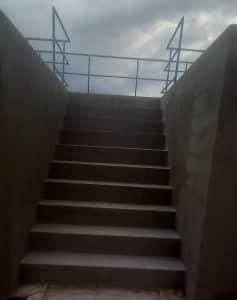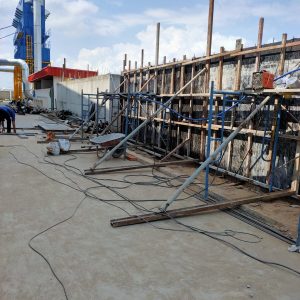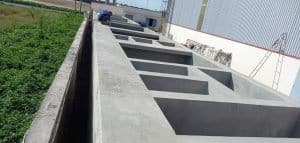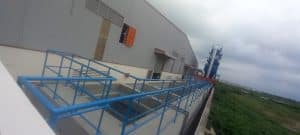Treatment of production and domestic wastewater is a practical need of many manufacturing factories. The amount of wastewater comes from two main sources: domestic wastewater of workers and wastewater generated from the factory’s production process. Depending on the flow and nature of each type, we can choose the appropriate technology. Below Nam Viet ETC would like to present the technology for treating domestic wastewater and wood production with equivalent flow rates.
The domestic and production wastewater treatment process is designed by Nam Viet
Nam Viet constructs and installs domestic and production wastewater treatment systems

Preparing to press piles to build a cluster of domestic and production wastewater treatment tanks
Close the wall formwork
Place connecting pipes between treatment tanks
Complete the rough part of the wastewater treatment tank

Complete the stairs to the treatment tank cluster
Installation of piping equipment, air discs, pumps, and completed railings
Sources of production and domestic wastewater generation
- From the stage of washing ingredients
- Wastewater from the process of painting and decorating wooden products…
- The process of cleaning processing machinery and equipment, cleaning the factory
- Wastewater for cleaning, cleaning, floor washing
- Domestic wastewater, hand washing, and employee hygiene
Production and domestic wastewater characteristics
- Substances that are difficult to biodegrade such as printing ink, paint, chemical solvents used in the wood industry…
- The characteristic of production wastewater is its very high COD content from 1000 – 2000 mg/l.
- Domestic wastewater contains many suspended solids, BOD, COD, NH4+, pathogenic bacteria…
- Nutrients nitrogen (N), phosphorus (P).
- The wastewater generated from the teen room contains a lot of oil and grease.
- In addition, waste from the production stage such as paper, plastic, glue, paint residue, wood chips… that are not completely collected can also enter the system.
- Organic substances in wastewater (about 55-65%) will reduce the amount of dissolved oxygen in the water, affecting the life of aquatic animals and plants.
- Nutrients of N and P cause eutrophication of sources receiving wastewater, affecting living organisms in the aquatic environment.
- Suspended solids cause water turbidity, creating sediment deposits that clog drains, pipes and gutters. But organic substances in domestic wastewater are easily biodegradable.
- The content of decomposed organic matter is determined indirectly through the biochemical oxygen demand (BOD) of wastewater.
| No. | Targets/ Targets | Unit/ Unit | Value/ Value |
| 01 | pH | – | 4 – 6 |
| 02 | BOD | mg/l | 500 -1000 |
| 03 | TSS | mg/l | 600 – 1000 |
| 04 | COD | mg/l | 1200 -2000 |
| 05 | Total Nitrogen | mg/l | 50 -100 |
| 06 | Total Phosphorus | mg/l | 10 -50 |
| 07 | Animal and vegetable fats and oils | mg/l | 50 – 200 |
| 08 | Coliform | MPN/100ml | 104 – 105 |
After-treatment wastewater standards QCVN 40:2011/BTNMT, Column B
| STT | Target | Unit | Value (QCVN 40:2011/BTNMT, Column B) |
| b | pH | – | 5.5 – 9 |
| 02 | BOD | mg/l | 50 |
| 03 | TSS | mg/l | 100 |
| 04 | COD | mg/l | 150 |
| 05 | Total Nitrogen | mg/l | 40 |
| 06 | Total Phosphorus | mg/l | 6 |
| 07 | Animal and vegetable oils and fats | mg/l | 10 |
| 08 | Coliform | MPN/100ml | 5,000 |
Production and domestic wastewater treatment plan
The wastewater treatment plan selected depends on the specific conditions of the Project and the treatment satisfies the following requirements:
- Does not make noise, does not cause unpleasant odors to the surrounding area
- Does not affect the aesthetics and general operations of the factory
- Simple management and operation, reasonable operating costs.
From the above characteristics and the requirements to be achieved after treatment, wastewater treatment technology includes the following main steps:
- Step 1: Use mechanical methods to remove large suspended substances and grease in wastewater
- Step 2: Use physicochemical methods to treat organic substances, COD, N, P, paint residue… of wastewater
- Step 3: Use anoxic combined aerobic biodegradation method to remove organic substances present in wastewater. Aims to continue to reduce the amount of Nitrogen, Phosphorus and organic pollutant content in water (COD; BOD)…
- Step 4: Use disinfection method to kill harmful microorganisms in water. Ensure output water meets discharge standards QCVN 40:2011/BTNMT Column B for industrial wastewater.
- Step 6: Sewage sludge will be pumped to the sludge tank and periodically sucked.
Flow chart of production and domestic wastewater treatment technology

Explain production and domestic wastewater treatment technology
Oil collection tank and grease separation tank.
- This wastewater stream after going through the local oil and grease collection and separation system (wastewater from the apartment must go through the grease separation module),
- will then be pumped into the 3-compartment collection tank. Before entering the 3-compartment collection tank, the wastewater must pass through a garbage separator with a gap of 2 – 4mm to avoid clogging the wastewater pump in the tank and to protect Protecting equipment for the rear unit project is .
- Having a wastewater collection pit will avoid uneven flow into the treatment system over time.
- The 3-compartment collection tank will retain most of the paint residue from the production process to avoid affecting the downstream processing process and improve the efficiency of the physical and chemical processing process.
- After entering the 3-compartment mechanical collection tank, wastewater is pumped by a submersible pump through the equalization tank.
Air conditioning tank
- Wastewater in the regulation tank is regulated in flow and stabilizes the concentration of pollutants.
- The conditioning tank has an aeration system that helps mix wastewater to ensure the concentration of pollutants in the tank is always maintained.
- At the wastewater treatment tank, wastewater is transported by 02 submersible pumps that operate alternately to pump through the neutralization tank.
Neutralization tank
- At the neutralization tank, with the support of the automatic pH controller, NaOH solution will be pumped in if the pH is below the optimal level of the process. next handler
- With the support of the stirring system, chemicals are evenly dispersed into the wastewater, helping to raise the pH to the optimal level so that the flocculation process takes place perfectly.
Flocculation tank
- At the coagulation tank the process of adding oppositely charged ions (positive charge) occurs to neutralize the charge of the colloidal particles in the water, increasing the zeta potential, breaks the strength of particles, preventing the chaotic movement of ions in water.
- The chemical used for the flocculation process is PAC and has stirring motor to enhance the performance of the flocculation process of pollutants, nitrogen, phosphorus, COD, organic substances, suspension…
Factors affecting the flocculation process:
- Effect of pH
- Water temperature
- Type and concentration of coagulant and flocculation aid
- Stirring speed
- After flocculation, the wastewater flows through gravity through the flocculation tank
Floating tank
- In the flocculation tank the process of linking the flocs together after the flocculation process occurs under the influence of stirring at a small speed to increase the size and volume of the floc. flocs so that the flocs can easily settle.
- Factors affecting the flocculation process: pH, temperature, stirring speed
- After flocculation, wastewater will flow by gravity to the physicochemical settling tank
Physical and chemical settling tank
- At the physical and chemical settling tank the chemical flocs during the flocculation process and organic residue will settle and be sucked through the sludge tank.
- Clean water after passing through the foam barrier and serrated trough will flow gravity through the neutralization tank.
- Sludge generated during the physical and chemical treatment process will be periodically sucked up by a functional unit.
- The wastewater in the settling tank will continue to flow through gravity through the anoxic biological tank.
Anoxic biological tank
- At the Anoxic anoxic biological tank wastewater is mixed by a submersible agitator to create an anoxic environment for microorganisms to operate and best process organic compounds and nitrates.
- At the anoxic tank, wastewater containing activated microbial sludge is circulated from the aerobic tank to ensure the best treatment time and environment.
- The process of Nitrate reduction occurs as follows: In an oxygen-deficient environment, these bacteria will reduce Nitrate Denitrificans will remove the oxygen of Nitrate (NO3- ) and Nitrite (NO2-) according to the metabolic chain:
NO3– → NO2– → N2O → N2↑
- Gas Nitrogen the N2 molecules formed will escape the water and go outside.
- Wastewater from the anoxic anoxic tank will flow gravity through the aerobic biological tank
Aerobic biological tank
- In the aerobic biological tank, suspended aerobic microorganisms will be exposed to toxic organic substances in the water such as ammonium and total nitrogen, BOD, COD ….</ li>
- In the aerobic tank, wastewater is mixed with activated microbial sludge
- Air is supplied from 2 air blowers that operate alternately 24/7 throughout the tank area, providing oxygen
- Creates a dissolved oxygen environment > 2mg/l is favorable for aerobic microorganisms to grow and decompose pollutants.
- Microorganisms will decompose organic substances into final products CO2 and H2O, reducing the concentration of dirt in wastewater.< /li>
- The aerobic biological tank is the unit that determines the treatment efficiency of the system because most of the pollutants in wastewater are organic substances that are easily biodegradable.
- The aerobic biological treatment process of wastewater includes the following stages:
- Oxidation of organic substances:
CxHyOz + O2 -> CO2 + H2O + DH
- Synthesis of new cells
CxHyOz + NH3 + O2 -> CO2 + H2O + C5H7NO2 + DH
- Intracellular degradation:
C5H7NO2 + 5º2 -> 5CO2 + H2O + NH3 ± DH
- In addition, the group of autotrophic microorganisms Nitrosomonas and Nitrobacter use nitrogen and phosphorus to metabolize nitrate and create biomass. The nitrification process occurs according to the following reaction equations:
NH3 + 3/2O2 -> NO2– + H+</sup > + H2O + biomass/biomass
NO2– + ½O2 -> NO3– + biomass /biomass
Phosphoritization Process:
Organic compounds containing phosphorus will be converted by the Acinetobacter bacterial system into new compounds that do not contain phosphorus and compounds that contain phosphorus but are easily decomposed by aerobic bacteria in wastewater from the suspended aerobic compartment. Gravitational flow through the biological sedimentation tank.
Biological settling tank
- At the biological sedimentation tank water will be separated from sludge.
- The microbial sludge will settle to the bottom and be circulated back to the anoxic biological tank. The excess sludge will be pumped to the sludge tank and periodically sucked by a functional unit.
- Clean water from the biological sedimentation tank, after passing through the foam barrier and serrated trough, will flow by gravity to the disinfection tank.
Disinfection tank
- At the disinfection tank Javen disinfectant chemical will be pumped in to kill harmful microorganisms.
- After the water is disinfected, it will be pumped by a submersible pump into the drainage system into the industrial park’s sewers.
- Output wastewater is guaranteed to meet column B, QCVN 40:2011/BTNMT for industrial production wastewater.
- Sludge generated during the process of physicochemical and biological treatment will be collected and stored in the sludge tank, ensuring compliance with state waste treatment regulations and the amount of sludge generated after a period of time. The space will be periodically absorbed by the unit with the treatment function
Advantages production and domestic wastewater treatment technology
- Physical and chemical treatment process :
- The process of treating nitrogen, phosphorus, synthetic organic matter, color… in wastewater with high treatment efficiency thanks to neutralizing chemicals, flocculation, flocculation, sedimentation…
- Proper mixing process of mixing motors, temperature, wastewater PH…
- Biological treatment process: is the process of treating nitrogen, phosphorus, and synthetic organic matter. In particular, the processes of nitrification and denitrification occur continuously in biological tanks.
- The denitrification process uses existing hydrocarbon sources in wastewater, without the need to add external hydrocarbon sources
- Limits the growth of filamentous bacteria and reduces caking and difficulty settling in sedimentation tanks because it does not use sedimentation tanks like traditional technologies.
- The process of denitrification occurs, raising the pH and alkalinity of wastewater, creating oxygen to help the nitrification process occur. favorable subsequent output, reducing the amount of gas needed for the nitrogen treatment process;
- Aerobic tanks with a high density of microorganisms per unit volume, the organic matter load is high, thus the organic matter treatment efficiency is higher and the ability to withstand shock high load. At the same time, due to the high density of microorganisms, the possibility of sludge generation is low.
- Physicochemical combined with biology is the most effective wastewater treatment technology today with the most reasonable investment cost.
- The system’s operating process is controlled completely automatically (can be operated manually), which eases operational work, saves electricity costs, and ensures quality. The amount of water after treatment is always stable and meets discharge requirements.
Common outstanding features of production and domestic wastewater treatment plans.
- Technology: Physicochemical method combined with biology
- Ensure treatment of COD and nitrogen in wastewater
- Nitrogen and ammonium treatment
- Fewer equipment, REDUCING electricity costs, consumable equipment, and maintenance.
- Technology solutions:
- Automatic control operation by Timer and manually, this eases operating work, saves electricity and chemical costs.
- The system operates safely, has high reliability, and is convenient for warranty and repair.
- Symbiotic microflora provides good treatment efficiency.
- Aesthetics: ensuring aesthetics, safety and convenience for direct operators of the system.
Nam Viet is a contractor for building domestic and production wastewater treatment systems. If you need advice or a design quote, please contact us for service. Hotline 0932562177






Bài viết liên quan
UASB tank in wastewater treatment
Introducing the UASB tank UASB stands for Upflow Anaerobic Sludge Blanket, roughly translated as reverse...
Wastewater treatment of carton paper packaging production
Origin of wastewater from carton packaging production Wastewater containing printing ink generated during the production...
Common Aerotank tank problems and how to fix them
Aerotank incidents during the operation of the WWTP often arise equipment problems such as pumps,...